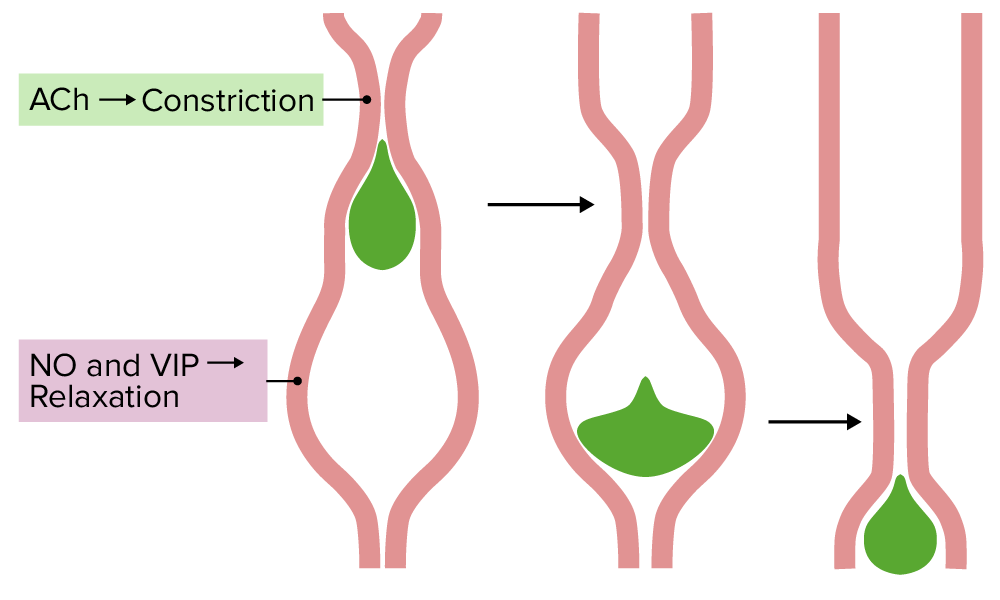Playlist
Show Playlist
Hide Playlist
Slow Waves – Gastrointestinal Motility
00:01 What controls these GI movements? These come back to these interstitial cells of Cajal. 00:08 These small little cells use a change in membrane potential to elicit different types of muscle contractions. 00:17 The frequency, however, of these muscle contractions vary depending upon if you’re in the stomach, the small intestine or the large intestine. 00:26 In the stomach, there are about 3 to 5 of these contraction waves that happen per minute. 00:34 In the small intestine, it’s about 12 to 20. 00:37 And the large intestine, about 6 to 8. 00:42 Now, slow waves are very hard to kind of visualize, so I’m going to show you a few in the next couple of slides. 00:48 The influence of these particular slow waves are usually not in terms of the rate, but rather their amplitude. 00:56 The higher the amplitude, the greater the contraction. 01:00 The lower the amplitude, the less of a contraction. 01:04 And this is where smooth muscle differs from skeletal muscles. 01:08 In skeletal muscle, either it contracts or it doesn’t. 01:11 In smooth muscle, it’s gradated, meaning that it can contract harder or less hard with any particular muscle fiber. 01:21 Okay. 01:21 So how does this process work? Well, you have to develop tension and you have these waves occurring. 01:31 So let’s look at this particular example of four slow waves. 01:37 Each of the slow waves causes a little change in muscle tone. 01:41 If there’s an increase in muscle tone, that’s a muscle contraction. 01:46 What those spikes are at the top of membrane potential are action potentials. 01:50 So it’s possible for a slow wave to reach and action potential. 01:55 But it is not necessary. 01:58 There still will be some contraction that occurs. 02:01 This is in a stimulated condition such as if you were in a relaxed and digest condition of the parasympathetic nervous system. 02:11 You see that in this case you have more action potentials occurring at the tops of these slow waves causing greater muscle contractions. 02:22 This is an inhibited condition such as what might happen with the sympathetic nervous system. 02:28 So it’s generating a little bit of a slow wave here. 02:30 But it’s not enough to cause much of a change in muscle tone. 02:35 So muscle tone is very much related to this slow wave, but also how many action potentials that are engaged once the slow wave reaches a certain amount of membrane potential. 02:51 And so you might ask, “Well, what controls these slow waves?” Well, the upward slope of the slow wave is usually done by a calcium channel and the return of that slow wave back down to more of a resting membrane potential is done by a potassium channel. 03:06 So it’s simply opening and closing the various channels done at different rates throughout the GI system. 03:13 Remember, it’s slower in the stomach, faster in the small intestine and again slower in the large intestine.
About the Lecture
The lecture Slow Waves – Gastrointestinal Motility by Thad Wilson, PhD is from the course Gastrointestinal Physiology.
Included Quiz Questions
Which of the following areas of the gastrointestinal tract has the highest frequency of slow waves?
- Small intestine
- Esophagus
- Stomach
- Large intestine
- Rectum
Which of the following statements is true?
- The interstitial cells of Cajal control the baseline frequency of muscle contractions in the GI tract, while the amplitude is changed by enteric neuronal inputs.
- The interstitial cells of Cajal control the baseline amplitude of muscle contractions in the GI tract, while the frequency is changed by enteric neuronal inputs.
- The interstitial cells of Cajal only increase the frequency and amplitude of muscle contractions in the GI tract.
- The interstitial cells of Leydig control the baseline frequency of muscle contractions in the GI tract, while the amplitude is changed by the interstitial cells of Cajal.
- The interstitial cells of Cajal only affect the amplitude of muscle contraction in the GI tract.
Customer reviews
5,0 of 5 stars
| 5 Stars |
|
5 |
| 4 Stars |
|
0 |
| 3 Stars |
|
0 |
| 2 Stars |
|
0 |
| 1 Star |
|
0 |




